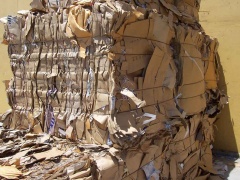Waste Paper
| Infobox on Waste Paper | |
|---|---|
| Example of Waste Paper |  |
| Facts | |
| Origin | - |
| Stowage factor (in m3/t) | 4.10 m³/t (bales, unpackaged, wire-strapped, from Cuba) 2.69 m³/t (old newspapers, bales unpackaged) |
| Humidity / moisture |
|
| Ventilation | Recommended ventilation conditions: air exchange rate: 6 changes/hour (airing), if the dew point of the external air is lower than the dew point of the hold air. |
| Risk factors | Waste paper which has been compressed into compacted bales, is impregnated with unsaturated oils and is not completely dry constitutes a fire hazard. Reference is made to the relevant IMO regulations on hazardous cargo. |
Waste Paper
Contents
Description
Paper recycling is the process of turning waste paper into new paper products. There are three categories of paper that can be used as feedstocks for making recycled paper: mill broke, pre-consumer waste, and post-consumer waste. Mill broke is paper trimmings and other paper scrap from the manufacture of paper, and is recycled internally in a paper mill. Pre-consumer waste is material which left the paper mill but was discarded before it was ready for consumer use. Post-consumer waste is material discarded after consumer use, such as old corrugated containers (OCC), old magazines, old newspapers (ONP), office paper, old telephone directories, and residential mixed paper (RMP). Paper suitable for recycling is called "scrap paper", often used to produce molded pulp packaging. The industrial process of removing printing ink from paperfibers of recycled paper to make deinked pulp is called deinking, an invention of the German jurist Justus Claproth.
Paper recycling process
The process of paper recycling involves mixing used paper with water and chemicals to break it down. It is then chopped up and heated, which breaks it down further into strands of cellulose, a type of organic plant material; the mixture is then called pulp, or slurry. It is strained through screens, which remove any glue or plastic that may still be in the mixture then cleaned, “de-inked,” bleached, and mixed with water. Then it can be made into new paper. The same fibers can be recycled about seven times, but they get shorter every time and eventually are strained out. Rationale for recycling
Industrialized paper making has an effect on the environment both upstream (where raw materials are acquired and processed) and downstream (waste-disposal impacts).
Today, 90% of paper pulp is created from wood. Paper production accounts for about 35% of felled trees, and represents 1.2% of the world's total economic output. Recycling one ton of newsprint saves about 1 ton of wood while recycling 1 ton of printing or copier paper saves slightly more than 2 tons of wood. This is because kraft pulping requires twice as much wood since it removes lignin to produce higher quality fibres than mechanical pulping processes. Relating tons of paper recycled to the number of trees not cut is meaningless, since tree size varies tremendously and is the major factor in how much paper can be made from how many trees. Trees raised specifically for pulp production account for 16% of world pulp production, old growth forests 9% and second- and third- and more generation forests account for the balance. Most pulp mill operators practice reforestation to ensure a continuing supply of trees. The Programm for the Endorsement of Forest Certification (PEFC) and the Forest Stewardship Council (FSC) certify paper made from trees harvested according to guidelines meant to ensure good forestry practices.[10] It has been estimated that recycling half the world’s paper would avoid the harvesting of 20 million acres (81,000 km²) of forestland.
From the point of view of quality, waste paper types are divided into light-colored grades (from printing and publication products, office paper, documents) and dark-colored grades (from packaging materials). Light-colored grades are used in graphic and sanitary papers and dark-colored grades are processed into packaging papers and cardboard.
Applications
Waste paper is used to produce:
- Paper, cardboard and paperboard for packaging
- Sanitary paper
- Special paper
- Graphic paper
Shipment / storage / usage
Waste paper is predominantly pressed into bales and strapped with wire for transport and storage.
Transport in standard containers, subject to compliance with limits for water content of goods, packaging and flooring.
It is imperative that the goods be protected from moisture (rain, snow etc.) during cargo handling, as the risk of spontaneous combustion may be increased. During cargo handling, the bales must not be lifted by the strapping, as this may break.
The cargo is to be secured in such a way that the bales or strapping are not damaged. Undamaged strapping is essential to maintain compression of the bales during transport.
Risk factors
- Self-heating / Spontaneous combustion
- Moisture
- Contamination
- Mechanical influences (during cargo handling, the bales must not be lifted by the strapping, as this may break).
Reference is made to the relevant IMO regulations on hazardous cargo.











